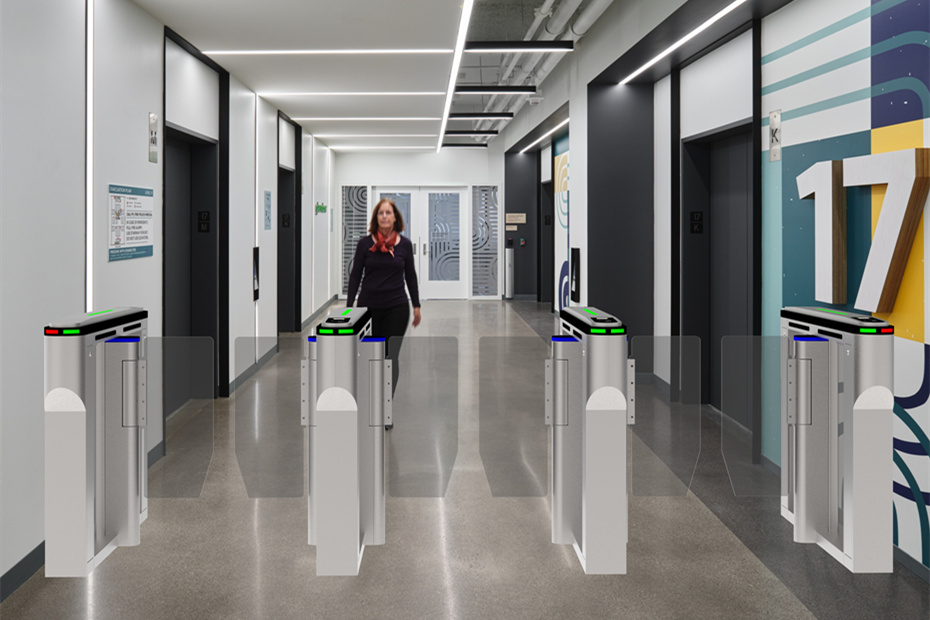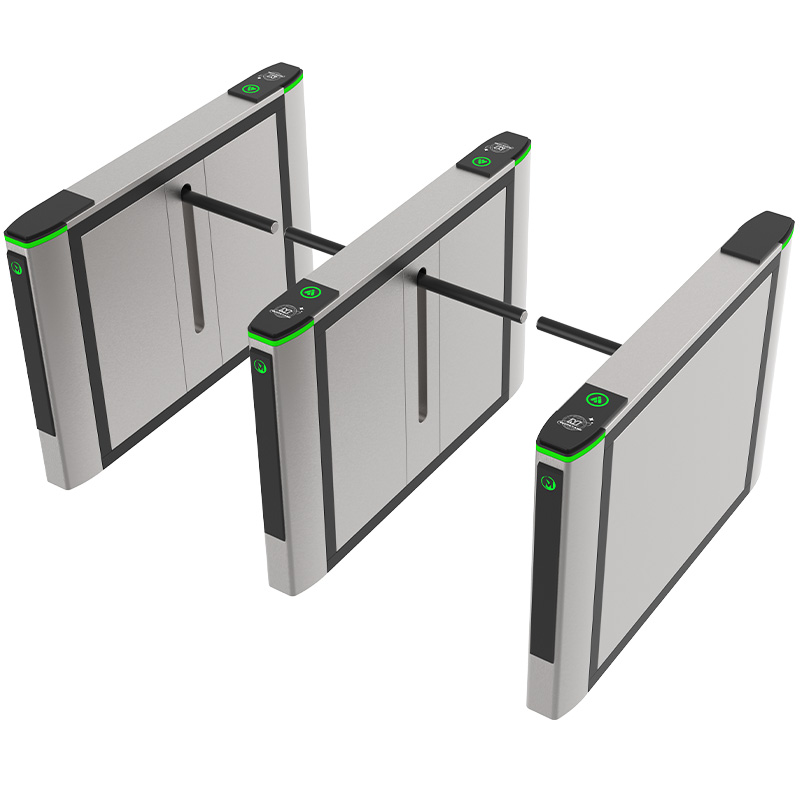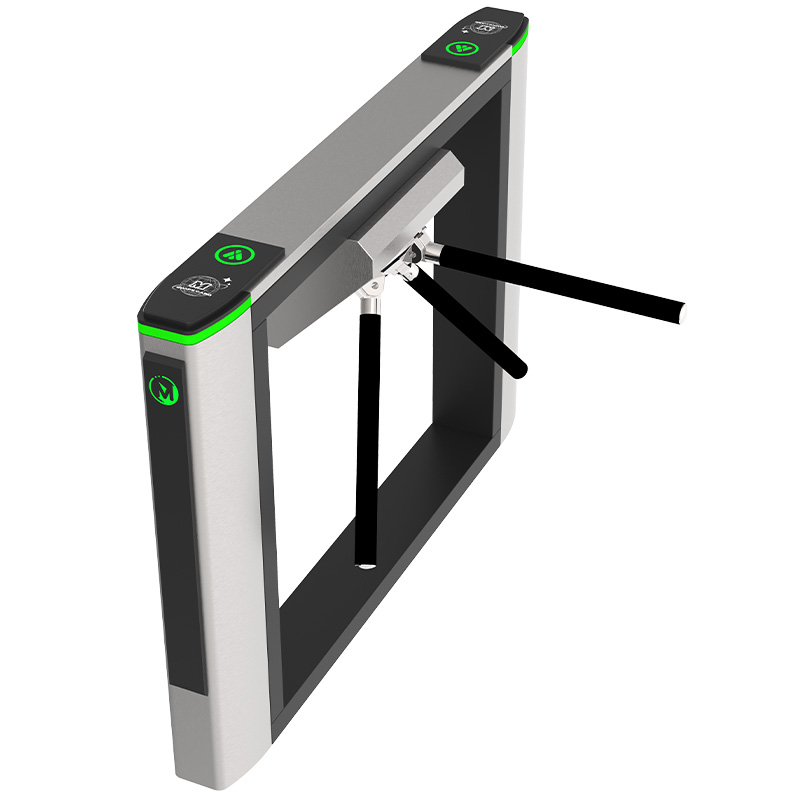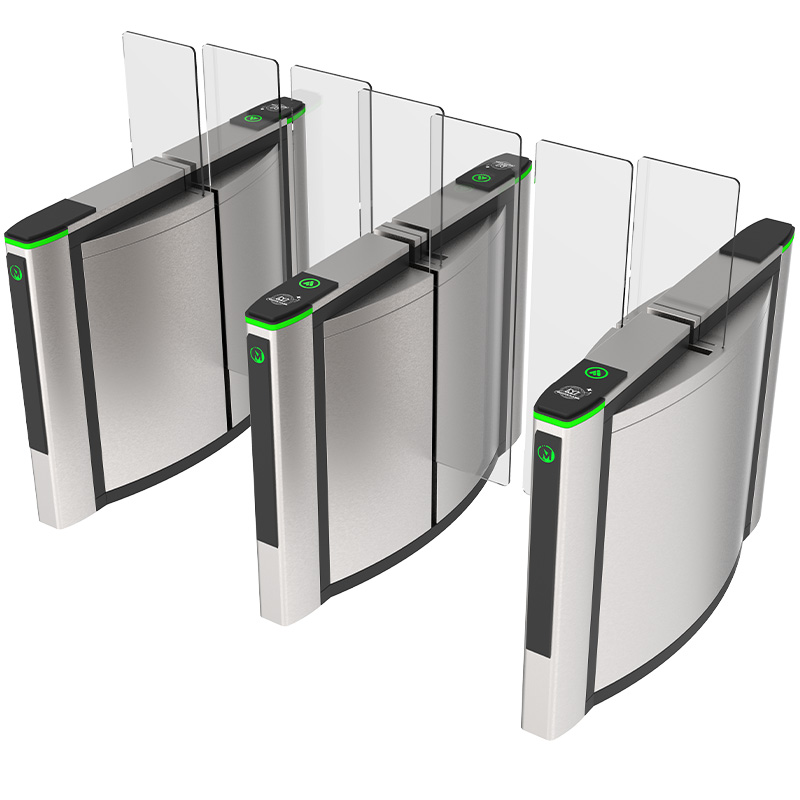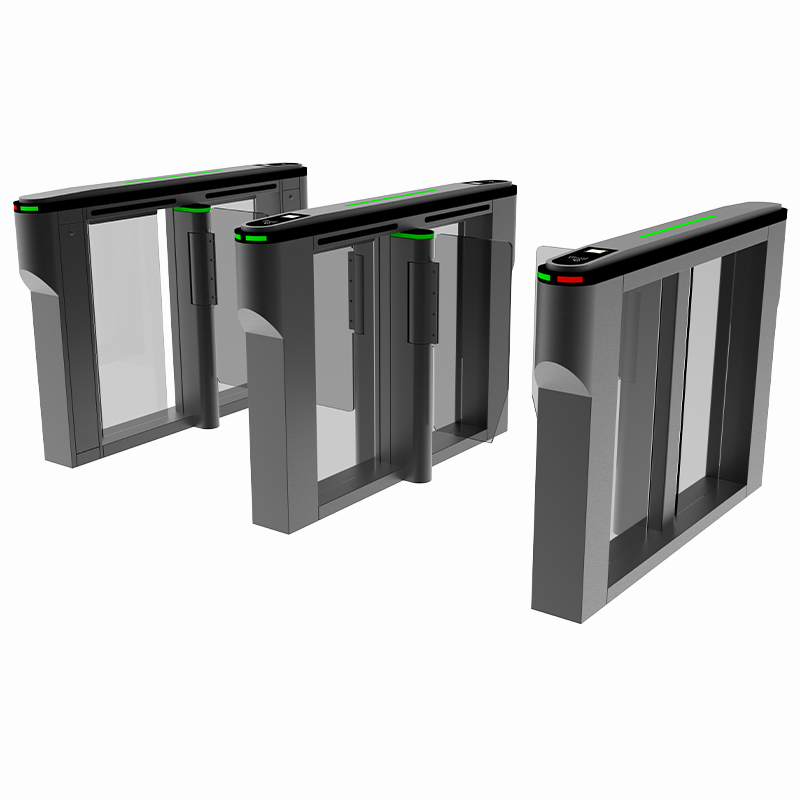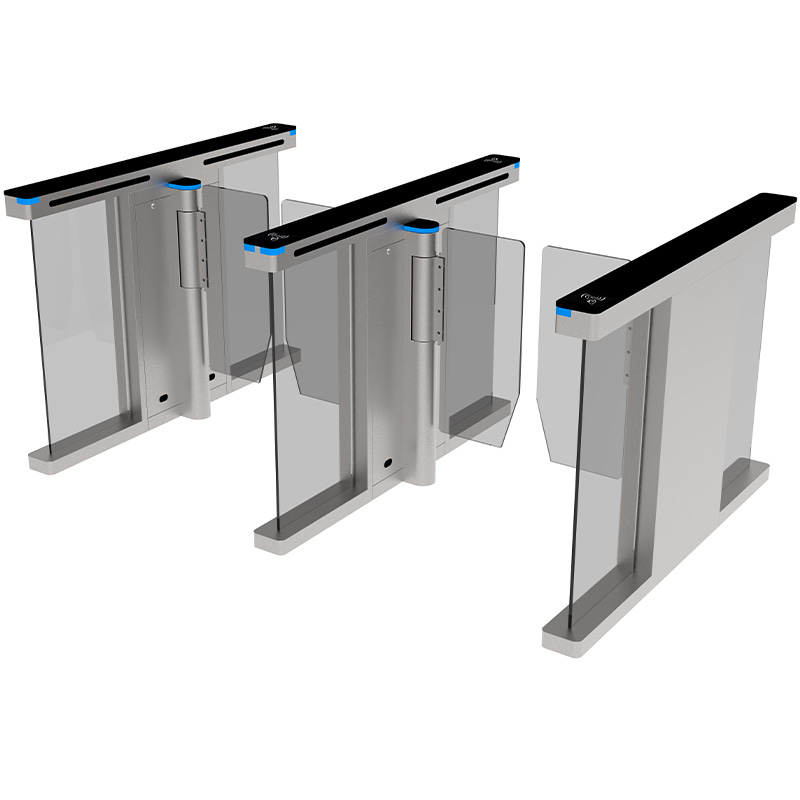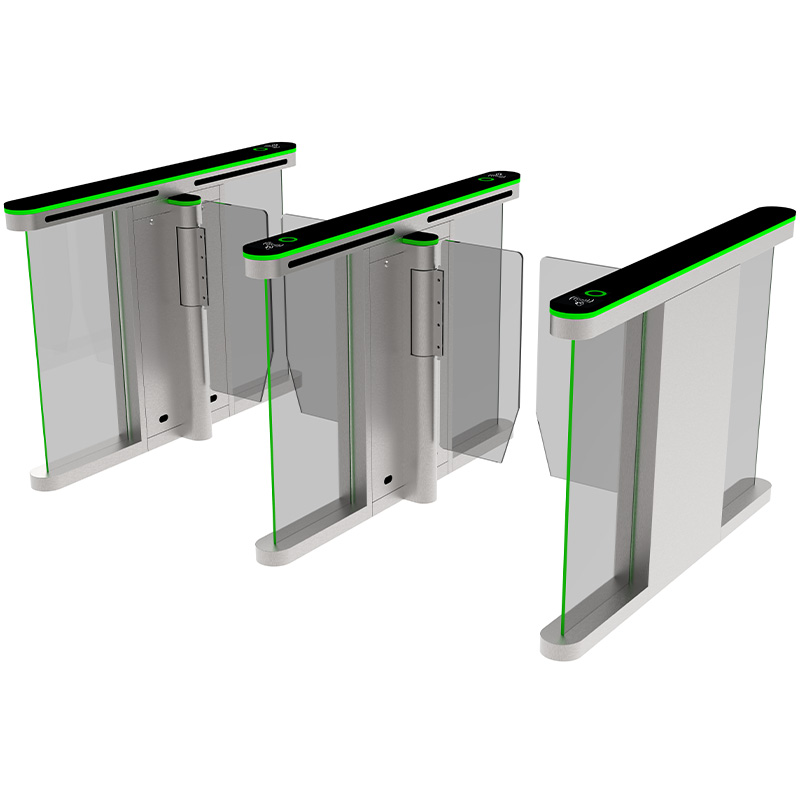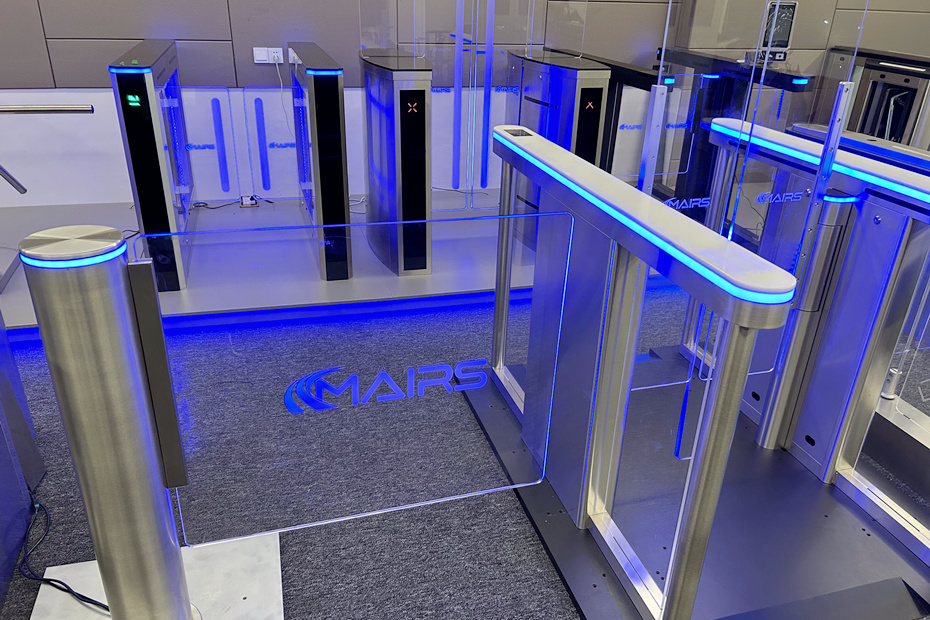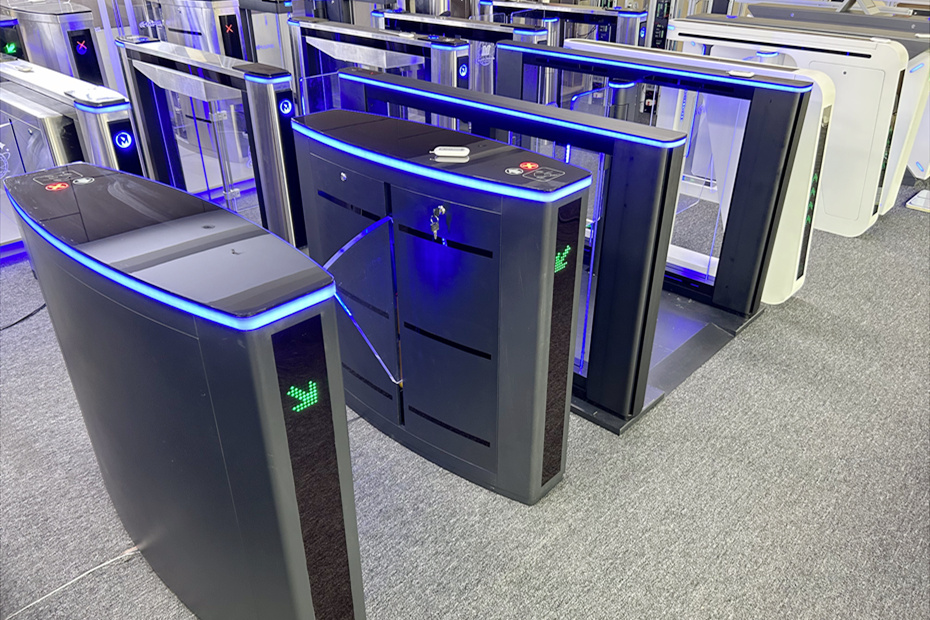Last updated on: December 20th, 2024 11:53 am
Turnstile access control system
A turnstile access control system is a security solution designed to manage and monitor the flow of people entering or exiting a secured area. The turnstile access control system serves as an effective means to manage and control the entry and exit of individuals in various environments. It integrates hardware components such as pedestrian turnstile gates with identification systems, offering a comprehensive solution for security and access management.
This system uses turnstiles, gates, or barriers equipped with access control technology to allow or deny entry based on the presented credentials. Its main function is to ensure that only authorized personnel can enter specific areas while providing an efficient and safe travel experience.
Basic composition:
The turnstile access control system is a complex system that combines various components to manage and control the entry and exit of individuals. Here is an overview of the basic composition of the turnstile access control system:
1. Pedestrian Turnstile Gate:
Turnstiles are physical gates or barriers installed at entry points. They can include tripod turnstiles, flap barriers, swing gates, or full-height turnstiles, depending on security requirements and the level of control needed.
2. Access Control Technology:
Access control technology is integrated into the turnstiles to authenticate individuals. Common methods include:
Proximity Cards: Users present a proximity card to a reader for authentication.
Biometric Readers: Fingerprint, facial recognition, or iris scanners verify a person’s identity.
Keypad/PIN Entry: Users enter a personal identification number (PIN) for access.
3. Control Panel/Controller:
The control panel or controller manages the communication between the turnstiles and the access control system. It processes authentication data and controls the operation of the turnstiles.
4. Authentication Database:
An authentication database stores user credentials, including card information, biometric data, or PINs. It is used to validate the identity of individuals seeking access.
5. Management Software:
Access control management software provides a user interface for system administrators to configure settings, manage user credentials, generate reports, and monitor access events. It allows for central control and monitoring of the entire system.
6. Integration with Other Systems:
Turnstile access control systems can integrate with other security systems, such as CCTV cameras, intrusion detection systems, and alarms. This integration enhances overall security measures and provides a comprehensive solution.
7. Alarm and Notification Systems:
In the event of unauthorized access attempts or security breaches, the system may trigger alarms and notifications to alert security personnel or administrators.
Key Features:
Customization and Flexibility:
The system should be flexible and customizable to accommodate different access control policies, user permissions, and security requirements based on the specific needs of the facility.
Audit Trail and Reporting:
A turnstile access control system maintains an audit trail of access events, providing a detailed record of who accessed the secured area, when, and through which turnstile. This information is valuable for security monitoring and audits.
Bi-Directional Control:
Turnstiles typically support bi-directional control, allowing authorized individuals to enter and exit. The system ensures that the number of entries matches the number of exits.
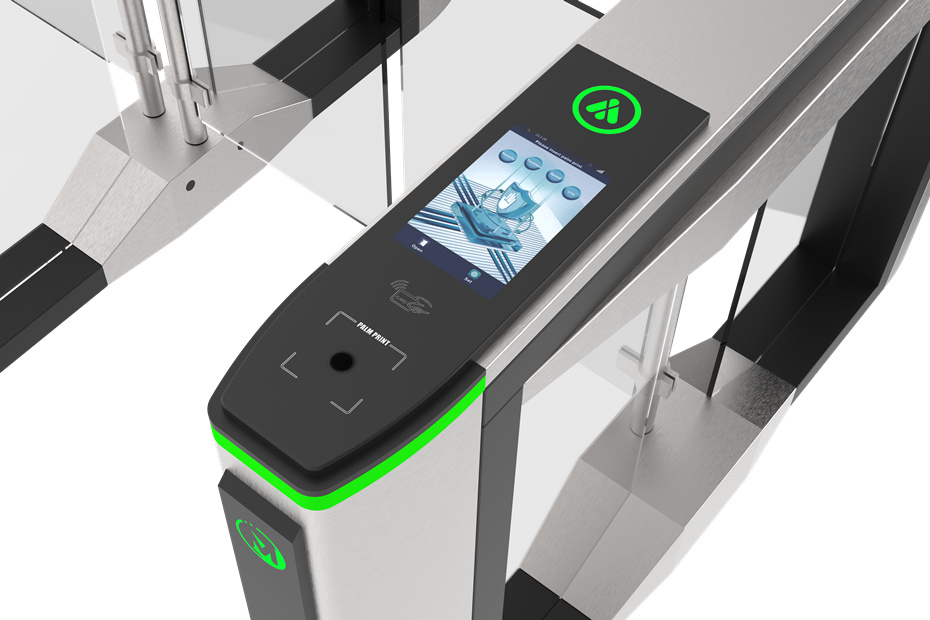
Benefits of Turnstile Access Control Systems:
Improved security and access control.
Efficient management of pedestrian traffic.
Integration with other security systems.
Customizable to suit different facility needs.
Enhanced monitoring and reporting capabilities.
A turnstile access control system provides a robust solution for managing access to secure areas, ensuring only authorized individuals can enter while maintaining an audit trail of all access events.
Common identification methods:
Common identification methods in turnstile access control systems include:
Password Recognition:
Users input a correct password to gain access. Easy to operate but has security concerns as passwords can be easily leaked. Suitable for one-way control.
Card Recognition:
Uses magnetic cards or radio frequency (RF) cards for access. Magnetic cards have a lower cost but are susceptible to wear, tear, and copying. RF cards offer contactless access, are more secure, and have longer service lives but are more expensive.
QR Code Recognition:
Personnel receive valid QR codes for entry, and a reading machine scans the QR code for access control. Convenient for managing personnel entering and exiting.
Biometric Recognition:
Identifies individuals based on unique biometric features. Examples include:
Fingerprint Recognition: Matches fingerprints for access. Provides high security but may have a high cost.
Facial Recognition: Uses facial features for identification. Offers high security without the need for cards but can be costly and has environmental and user requirements.
Vein Recognition: Identifies individuals based on vein patterns. Provides high security but may have a higher cost.
Each identification method has its advantages and disadvantages, and the choice depends on factors such as security requirements, cost considerations, and user preferences. Biometric recognition methods are gaining popularity for their high-security levels, while traditional methods like card recognition remain common. QR code recognition provides a convenient and contactless option for access control.
Basic functions:
The Turnstile Access Control System functions to manage and control the entry and exit of individuals in a secure and organized manner. Here are the primary functions of a turnstile access control system:
Access Verification:
Verify the identity of individuals seeking entry through authentication methods such as card swiping, biometric recognition (fingerprint, facial recognition), PIN entry, or QR code scanning.
Entry Permissions:
Grant or deny access based on the verified identity and predefined access permissions associated with the individual.
Access Control:
Verify and authenticate individuals attempting to enter a secured area using identification cards, such as IC cards, ID cards, QR codes, etc.
Control access based on permissions assigned to the identification card. Only authorized personnel are allowed entry.
Permission Management:
Set and manage access permissions for specific individuals, groups, or during specified time periods.
Time and Attendance Tracking:
Record and track the entry and exit times of individuals, providing accurate time and attendance data.
Biometric Recognition:
Use biometric data, such as fingerprints or facial features, for more secure and reliable identity verification.
Visitor Management:
Manage the entry and exit of visitors by issuing temporary access permissions and tracking their movements.
Channel Opening and Closing:
Operate the turnstile gate equipment to open and close the passage channel based on the verification results.
Achieve controlled passage through mechanisms such as rotating arms, swinging barriers, flaps, sliding gates, or full-height turnstiles.
Centralized Control:
Utilize access control controllers as the central control application to manage and coordinate the overall turnstile system.
Control the functionality of turnstile gate equipment, ensuring synchronization and proper functioning.
Card Reading:
Use card readers to read information from identification cards, transmitting the data to the access control controller.
Support various types of cards, including ID cards, IC cards, and CPU cards, depending on the system’s requirements.
Identity Verification:
Authenticate individuals through multiple identity verification methods, such as passwords, fingerprint scanning, or other biometric measures.
Enhance security by employing smart cards and advanced verification technologies.
Real-time Monitoring:
Monitor the entry and exit of individuals in real-time, keeping track of access events and recording relevant data.
Enable administrators to oversee the system’s operation and respond to any irregularities promptly.
Sensors:
Implement sensors, coils, and devices to detect various states, including entry and exit of personnel, one-way or two-way traffic, etc.
Enhance the system’s ability to adapt to different traffic scenarios and maintain security.
Alarm System:
Integrate sound and light alarms into the system to provide audible and visual alerts in response to security events or unauthorized access attempts.
Implement additional security measures such as video monitoring to enhance safety and deter potential threats.
Data Management:
Manage information related to personnel entry and exit, allowing administrators to add or delete data as needed.
Support data analysis and reporting functions for better understanding and optimization of system performance.
Multi-functionality:
Provide a versatile system that can be used in combination with attendance systems, charge management, ticket systems, and other software applications.
Facilitate various management functions, including employee card access control, commuting attendance, dining management, etc.
In summary, the turnstile access control system plays a crucial role in ensuring secure, organized, and efficient entry and exit processes, incorporating advanced technologies and features to enhance overall access control and security.
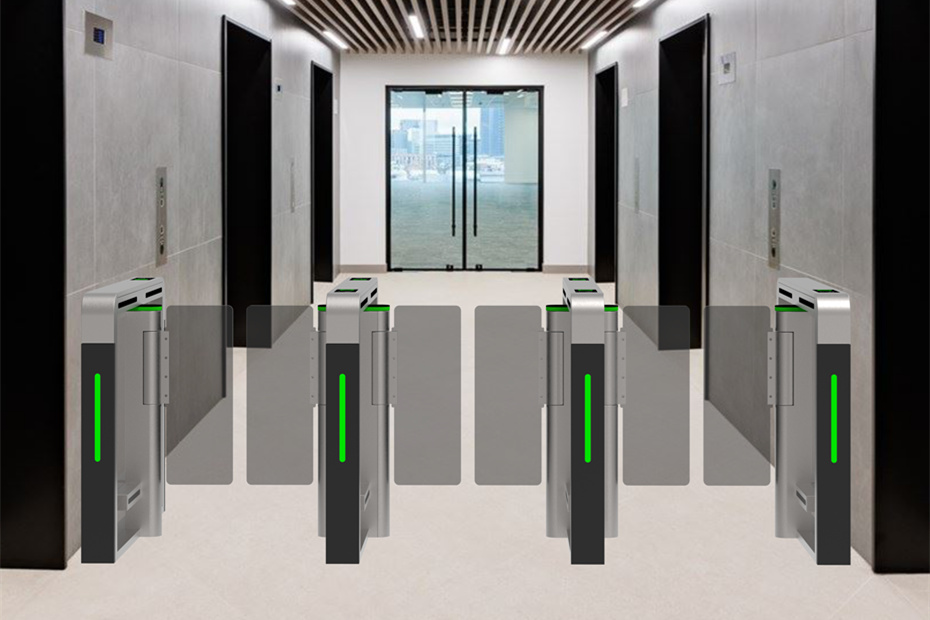
In short, the turnstile access control system is not only a necessary facility for public place channel management, but also a basic equipment for modern enterprise internal management. It can help enterprises improve safety, personnel management efficiency, and information technology level, and promote enterprise development.
The function of the intelligent turnstile access control system shall meet the actual needs and shall not be flashy. If the one-sided pursuit of the leading potential of the system will lead to excessive investment and deviate too far from the actual needs. Therefore, the practicability of the system is the first principle that should be followed first. At the same time, the front-end products and system software of the system have good learnability and operability. In particular, operability (convenience) enables managers with primary computer operation levels to master the operation essentials of the system through simple training and reach the operation level of completing duty tasks.
System Advantages:
The turnstile access control system offers various advantages for managing and securing entry points in different environments. Here are some key advantages:
Enhanced Security:
Provides a controlled and secure entry system, preventing unauthorized access and enhancing overall security.
Biometric Authentication:
Integrates advanced biometric authentication methods, such as fingerprint or facial recognition, for heightened security and accurate identification.
Time and Attendance Tracking:
Records and tracks the entry and exit times of individuals, facilitating accurate time and attendance tracking for employees.
Data Logging and Reporting:
Logs entry and exit data, providing a valuable resource for auditing, compliance, and generating reports on access patterns.
Prevention of Tailgating:
Reduces the risk of tailgating or piggybacking by allowing entry only to individuals with valid credentials.
Operational Flexibility:
Offers flexible configurations, such as setting turnstiles to be normally open or normally closed based on operational requirements.
Integration with Other Systems:
Integrates with other security systems, such as surveillance cameras and fire alarms, for a comprehensive security solution.
Queue Management:
Regulates the flow of people, preventing overcrowding and ensuring a smooth entry process, particularly in high-traffic areas.
Remote Monitoring and Control:
Allows for remote monitoring and control of the access control system, providing flexibility for security personnel.
Customizable Settings:
Supports customizable settings for access permissions, configurations, and security parameters based on the specific needs of the environment.
Operational Efficiency:
Streamlines entry processes, reducing bottlenecks and improving overall operational efficiency.
Deterrence of Unauthorized Access:
Serves as a visible deterrent to unauthorized individuals, discouraging attempts at illegal entry.
Cost-Effective Solution:
Provides a cost-effective and scalable solution for access control and security, especially when compared to traditional security measures.
Reduced Dependency on Physical Keys:
Eliminates the need for physical keys, reducing the risk of key loss or duplication.
Overall, the turnstile access control system offers a comprehensive and efficient solution for managing access and ensuring a secure environment.
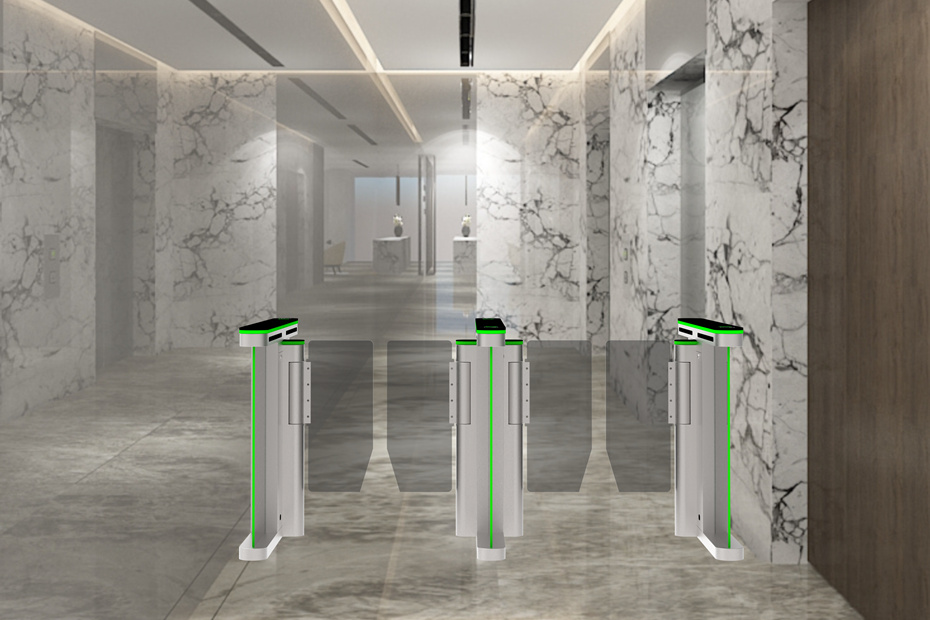
Working principle:
The working principle of a turnstile access control system involves the integration of hardware components, identification methods, and control mechanisms. Here’s a general overview of how a turnstile access control system operates:
Identification Methods:
Individuals seeking entry are required to authenticate themselves using various identification methods. Common identification methods include:
Card Reader: Individuals present access cards (such as RFID cards) to a card reader for verification.
Biometric Recognition: Utilizes biometric data (fingerprint, facial features, iris scan) for accurate identification.
Password/PIN Entry: Individuals input a unique password or PIN for authentication.
QR Code Scanning: Scan QR codes displayed on mobile devices or access cards.
Access Control Terminal:
The identification data is processed by an access control terminal, which can include a display screen, microphone, speaker, and input methods.
Access Control Controller:
The access control controller is the central processing unit of the system. It verifies the authentication data received from the access control terminal and determines whether to grant access.
Permission Verification:
The controller checks the identification data against pre-registered information in the system’s database. It verifies whether the individual has the necessary permissions to access the secured area.
Turnstile Gate Activation:
If the verification is successful, the access control controller sends a signal to activate the turnstile gate, allowing authorized entry.
Turnstile Movement:
The turnstile gate opens to permit entry, and the individual can pass through. The movement of the turnstile can be in the form of swinging arms, sliding barriers, or full-height turnstile rotation, depending on the specific type of turnstile.
Time and Attendance Tracking:
The system logs the entry event, recording the time and identity of the individual. This data can be used for time and attendance tracking purposes.
Alarms and Notifications:
If there is an attempt at unauthorized entry or if there’s an issue with the authentication process, the system may trigger alarms and notifications. This can include audible alarms, visual alerts, or notifications sent to security personnel.
Integration with Other Systems:
The turnstile access control system can be integrated with other security and management systems, such as surveillance cameras, fire alarms, and visitor management systems, enhancing overall security measures.
Remote Monitoring and Control:
Some systems offer remote monitoring and control capabilities, allowing security personnel to manage the system from a central location.
Queue Management:
In high-traffic areas, the turnstile access control system can regulate the flow of people, preventing overcrowding and ensuring a smooth entry process.
Fire Safety Integration:
In the event of a fire or emergency, the system can integrate with fire alarm systems to automatically open turnstiles, facilitating a quick and safe evacuation.
The working principle of a turnstile access control system is centered around accurate identification, permission verification, and controlled access to secure areas. It enhances security, ensures compliance with access policies, and provides a record of entry events for monitoring and analysis.
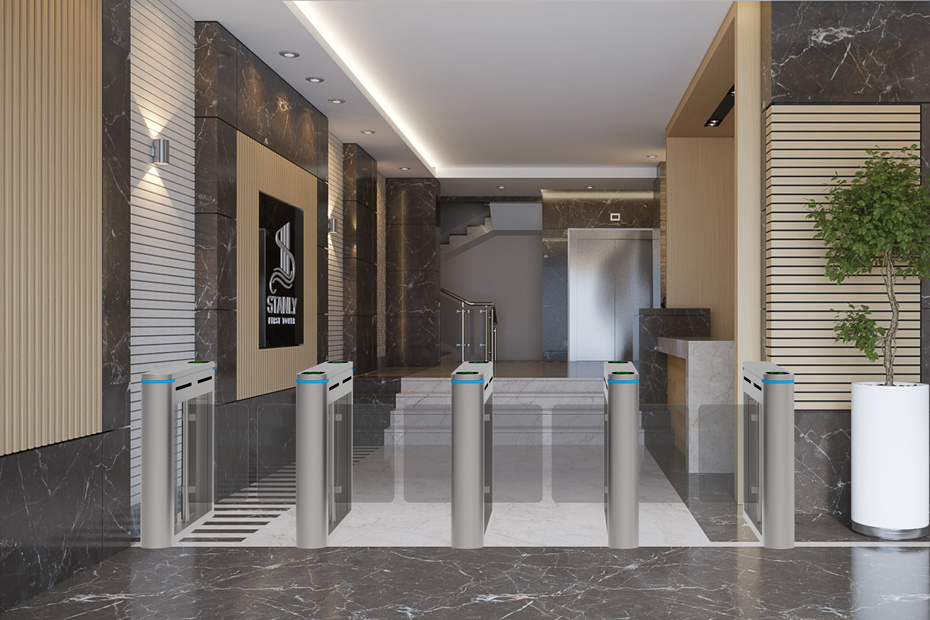
System Design principles:
Due to the need for safe and efficient management, the design of an anti-static access control system should follow the following principles:
The practicability of the system
The content of the access control system should meet the actual needs, not be flashy. If the one-sided pursuit of the leading nature of the system, It is bound to cause too much investment and too far away from the actual needs. Therefore, The practicability of the system is the first principle to be followed. At the same time, the front-end products and system software of the system have good learnability and operability. In particular, the operability enables the management personnel with primary computer operation level to master the operation essentials of the system through simple training, so as to achieve the operation level of completing the duty task.
The stability of the system
Because the access control system is an uninterrupted long-term work system and is closely related to the normal operation of our electrostatic workshop, the stability of the system is particularly important. The system should have more than three years of successful application experience in the market and corresponding customer groups and customer service system
System Security
All equipment and accessories in the access control system operate safely and reliably, It should also comply with relevant Chinese or international safety standards, And it can work effectively in a non-ideal environment. The powerful real-time monitoring function and linkage function fully ensure the security of the user environment.
System maintainability
The maintenance of the access control system in the process of operation should be as simple as possible. The operation of the system can work when the power is turned on, The extent to which you can plug it in. And there is no need to use too many special maintenance tools in the maintenance process. From the configuration of the computer to the configuration of the system, the configuration of the front-end equipment has fully considered the reliability of the system.
When we achieve the lowest system failure rate, we also consider that even when problems occur due to unexpected reasons, we can ensure the convenient storage and rapid recovery of data, and ensure that the channel can be opened quickly in case of emergency. The maintenance of the whole system is online, and the normal operation of all equipment will not be stopped because of the maintenance of some equipment.
Facial recognition system
Facial recognition turnstile access control system is a new choice for enterprise access management. In today’s office environment, a turnstile access control system is one of the devices that ensure security for enterprises. With the continuous progress of science and technology, traditional turnstile access control systems are gradually unable to meet the security needs of modern enterprises. Therefore, facial recognition turnstile access control systems have gradually become an important choice for enterprise turnstile access control management.
The facial recognition turnstile access control system is an intelligent turnstile access control system based on facial recognition technology. Compared with traditional turnstile access control systems, it has higher security and convenience. The system adopts advanced facial recognition technology, which can quickly and accurately identify the identity information of employees and complete the gate opening operation within a few seconds. It can effectively prevent strangers from entering the enterprise and achieve automated management of all staff attendance and employee attendance records.
Compared with traditional turnstile access systems, facial recognition turnstile access systems have the following significant advantages:
1. High security: Adopting facial recognition technology, it can accurately identify employees’ identities and prevent illegal intrusion and malicious damage.
2. Highly convenient: Employees do not need to carry access cards or other items, and only need to perform facial recognition to complete the door opening operation, saving a lot of time and energy.
3. Automated management: The facial recognition access control system can achieve automated processing of all staff attendance management and employee attendance records, improving management efficiency and accuracy.
In summary, the facial recognition turnstile access control system is a new-generation choice for enterprise access management, providing more efficient, secure, and convenient access control services. With the continuous innovation and improvement of technology, facial recognition turnstile access control systems will be more widely used in the future market.
The above provides a general introduction about the face recognition turnstile access control system., let’s take a look characteristics of the face recognition turnstile access control system
1. After the trailing pedestrian leaves the protection detection area, the first safety detection area detects unauthorized entry, and the door is closed, the alarm sounds, and the face recognition turnstile access control system has functions such as illegal intrusion alarm, reverse intrusion alarm, trailing alarm, and timeout alarm.
2. Equipped with a digital encoder, it automatically corrects the swing angle, and the synchronization performance of the AB swing door is strong.
3. LED directional traffic indication, indicating channel status, guiding pedestrians to pass quickly.
4. The face recognition turnstile access control system is equipped with mechanical and photoelectric dual protection and anti-pinch, and the damping transmission of the swing door is automatically separated.
5. The face recognition turnstile has zero noise, stable and durable performance, sturdy appearance, and is not easy to wear.
6. When the swing turnstile gate is impacted by external forces, the face recognition turnstile access control system can automatically buffer the deflection angle to prevent damage to the swing turnstile.
7. Pedestrians reverse and exit the pedestrian through the second safety detection area. Before the gate is restored to its basic state, the second safety detection area that has not issued a legal door opening signal once again detects someone entering, and the facial quick access door access control system alarms.
What are the characteristics of the face recognition turnstile access control system? After the above introduction, I believe everyone should be clear now. In recent years, facial recognition technology has been widely used on various platforms, and facial recognition turnstile access control systems have also been widely favored. If you have any related needs, please contact our online customer service.
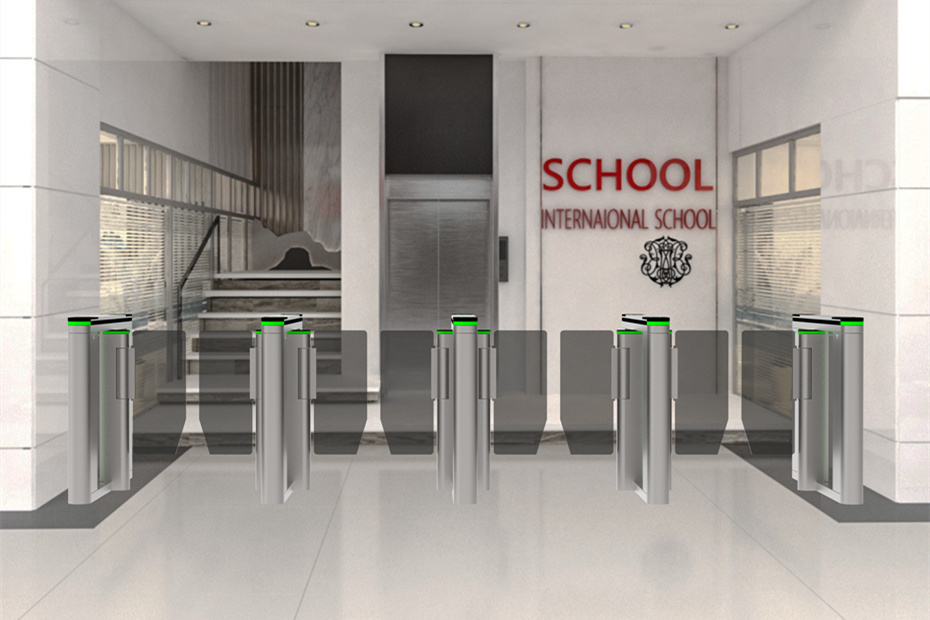
Fault resolution
Nowadays, many places have used face recognition access control turnstile gates, and face recognition has also brought considerable convenience to users. In daily use, there may also be some malfunctions in the face recognition turnstile access control system. So, let’s briefly talk about common solutions to face recognition turnstile access control system malfunctions.
Common face recognition turnstile access control system failure solutions:
1. The possible reasons for the problem of the facial recognition machine not opening the door and the screen being stuck during verification include: the network signal line is not connected properly, the power supply cannot be supplied normally, the unlocking signal is not output during verification, and the supporting electronic lock is malfunctioning. The steps to solve the problem with the facial recognition machine are as follows: reconnect the signal line for testing, short circuit the GND/PUSH test, connect the COM detection signal, and it is recommended to replace it with a new electronic lock detection.
2. The issue of the device fill light being on for a long time, especially in enterprise office applications, can have a certain impact on the working environment. When purchasing a device terminal, it is necessary to communicate with the supplier clearly whether it is possible to choose to adjust the fill light on time or whether the device can automatically adjust the fill light brightness based on light changes.
3. The problem of misidentification on the device can be solved by raising the recognition threshold. Generally, the higher the threshold, the lower the likelihood of misidentification. However, it should also be noted that the higher the threshold, the slower the speed of facial recognition. Recognition rate and speed are a double-edged sword. To find the right balance, the above problems can be avoided. Those who can achieve this should be professional manufacturers of facial access recognition machines.
The above briefly introduces several common solutions to the failure of the facial recognition access control system, but it is still recommended that users should seek professional personnel from the manufacturer to handle the failure of the facial recognition turnstile.
Introduction of system software
No matter what kind of access controller you choose, it will be equipped with corresponding management software. The functions that software can achieve are basically the same. The turnstile access control system software has a friendly user interface, convenient and simple operation, hierarchical display of all English characters, window mouse operation, automatic disk recording, and various query methods. Because the system software adopts a database format, it can be compatible with other office software. Attendance and personnel management can be carried out.
Regardless of the specific type of access controller, it comes equipped with corresponding system software. The functionalities of the software are generally similar across different systems. Here’s an overview of the features commonly found in turnstile access control system software:
User-Friendly Interface:
The system software features a user-friendly interface with convenient and simple operation. It often employs hierarchical displays in English characters, window mouse operation, automatic disk recording, and various query methods.
Compatibility and Integration:
Since the system software adopts a database format, it is compatible with other office software. It supports attendance and personnel management, providing a versatile platform for organizational needs.
Device Configuration and Initialization:
Allows the setting of pedestrian turnstile gate addresses, initialization of card machines, clearing and sorting of card machine equipment, and checking and setting of date and time.
Door Opening and Closing Settings:
Enables the setting of door opening and closing status, including rest days. It allows configuring door opening schedules for different times of the day.
Access Control Configuration:
Provides options to set the way to access the door, access methods, and management of user cards. This includes adding and deleting user cards and setting the date period for user cards.
Software Parameter Settings:
Allows basic parameter setting of software, including password configuration and personal basic parameters.
Initialization and Database Management:
Performs the initialization of software hard disk information (data initialization) and offers a Database Doctor feature to sort out the tables of the software.
Departmental Input and Setting:
Facilitates department input and setting for better organizational structuring.
Personnel Information Query:
Allows querying personnel information, providing a detailed overview of individuals within the system.
Data Extraction and Statistics:
Extracts and converts punch-in information from the card machine, and conducts daily access data statistics, and monthly data statistics.
Operating System and Software Integration:
The system software operates on the WIN2000 or WinXP operating platform, integrating with the operating system and other software components.
Real-time Monitoring:
Monitors entry/exit personnel in real-time, editing each door area, programming the system, and querying all emergency and personnel access data in real time.
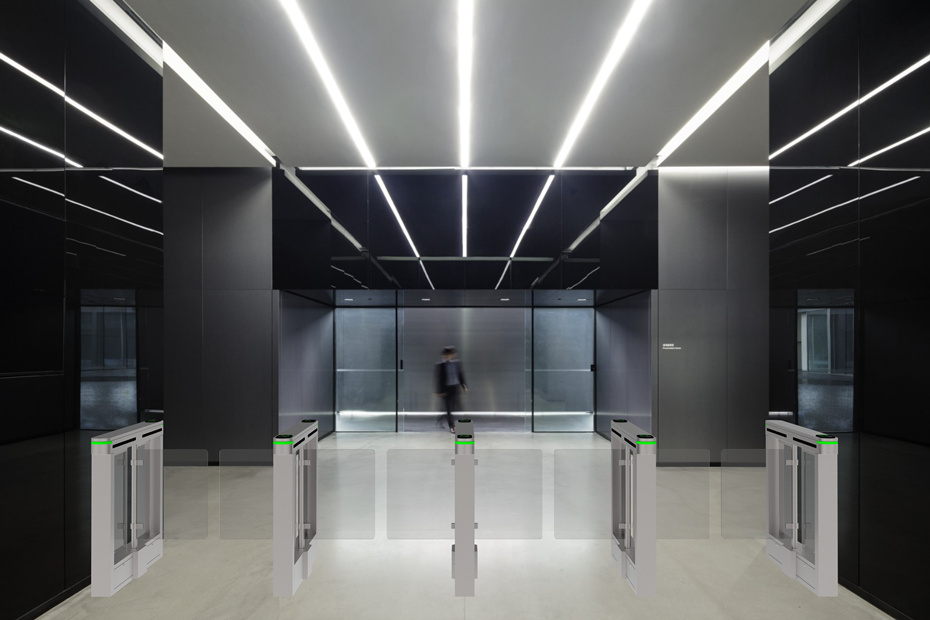
Database Management:
The software database adopts a standard SQL server or access database with an ODBC general access interface. It provides import and export functions in Excel file format.
Storage and Reporting:
Classifies storage system information and reports for easy search and retrieval. The reporting feature aids in comprehensive data analysis and management.
In summary, the system software for turnstile access control is a powerful tool that streamlines the configuration, management, and monitoring of access control systems. Its user-friendly interface and diverse functionalities make it an essential component in ensuring effective security and personnel management.

